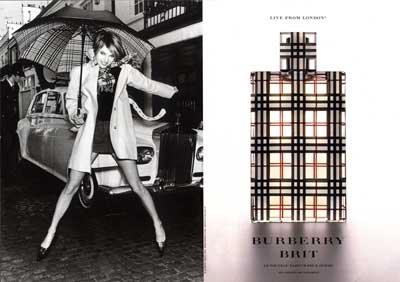浅褐、黑、红、白的四色格子魅力非凡,于不经意间诠释着纯纯的英伦风情;皇室成员、探险家、大明星……人人都爱巴宝莉,我们一起来看看这风靡世界的风衣名牌——巴宝莉——如何缔造它的品牌传奇……

By Susan Pfiefer
卓言 选 孔媛媛 译
|
Like the Chanel suit and the Birkin bag, the Burberry trench coat is one of fashion’s most iconic pieces. Its globally recognized name, trademark, and signature trenchcoat have been synonymous with quality and enduring style for over 150 years. Founder Thomas Burberry was born in 1835 and apprenticed in the drapery trade, establishing his own drapery business in Basingstoke, Hampshire, in 1856. A sportsman, Burberry was dissatisfied with the then-popular rubberized raincoat, which was heavy, restricting, and stifling, and thus unsuitable for extended outings. Inspired by country folk’s loose “smocks”, Burberry designed a tightly woven fabric made from water-repellent linen or cotton yarn. Although sturdy and tear-resistant, this “Burberry-proofed” cloth was lightweight and allowed air to circulate, making it considerably more comfortable than the heavy mackintosh. The tailor trademarked his cloth “Gabardine”, a Shakespearean term that referred to shelter from inclement weather. Burberry developed five different weights of gabardine. He even patented “Burberry-proofed” linings made from silk and wool. The gabardine name was used under exclusive trademark by Burberry until 1917. Britain’s King Edward, one of the first members of the royal family to don the gabardine coat, has been credited with popularizing the Burberry name by requesting the garment by name. Burberry garments have enjoyed a loyal following among royalty and celebrities around the world ever since. The company’s clientele has included Winston Churchill, George Bernard Shaw, Ronald Reagan, George Bush, Norman Schwarzkopf, and Paul Newman. The company also boasts warrants (endorsements of quality) from Her Majesty Queen Elizabeth II and H.R.H. The Prince of Wales. Many officers began to wear trench coats at the turn of the century, during the Boer War in South Africa. Famous British generals, such as Lord Kitchener and Lord Baden-Powell preferred the lightweight cotton of trench coats to the heavier, rubberised Macintoshes they had been used to. With such powerful recommendations, the War Office gave its official approval to the trench coat in 1901, with the Admiralty for the Royal Marines following suit in 1906. And as Lord Kitchener, Commander in Chief of the British Army, began fashioning the trench coat—then referred to simply as a “Burberry”—the place of this clothing item in society was sealed. With the advent of trench warfare in 1914, trench coats became an essential piece of the military outfit, with added epaulettes and “D” rings to enable the attachment of military equipment. As the trench coat, then the world’s most durable weather coat, was popularised, it is estimated that between 1914 and 1918, 500,000 military trench coats were worn by combatant officers. When officers returned home after the war, they brought back their trench coats with them and the style became adopted into civilian life. Since then, the trench coat has become a significant cultural icon and has been donned by many famous movie stars, from Humphrey Bogart in Casablanca to Audrey Hepburn in Breakfast at Tiffany’s. The company designed hats, jackets and pants especially for hunting, fishing, golf, tennis, skiing, archery, and mountaineering. The garments’ time—and weather-tested reputation for durability helped make them the gear of choice for adventurers of the late 19th and early 20th century. Balloonists and early aviators wore specially made Burberry garments that let neither wind nor rain penetrate. Captain Roald Amundsen, Captain R.F. Scott, and Sir Ernest Shackleton wore Burberry clothing and took shelter in Burberry tents on their expeditions to the South Pole in the 1910s. Rainwear became so important to Burberry that the company soon whittled its lines down to little more than trench coats and tailored menswear for much of the 20th century. The conservative manufacturer stuck primarily to its well-known raincoats until the 1960s, when a fluke led Burberry to capitalize on the garments’ trademark tan, black, red, and white plaid lining. It all started with a window display at the company’s Paris store. The shop’s manager spiced up her arrangement of trench coats by turning up the hem of one coat to show off its checked lining, then repeated the check on an array of umbrellas. The clamor for the umbrellas was so immediate and compelling that Burberry’s made and quickly sold hundreds. This experiment eventually led to the introduction of the cashmere scarf, also a perennial best-seller. Burberry’s success continued throughout the decades. Many more stores have sprouted from the very first outfitters shop in Basingtoke. In the early 20th century, stores opened in Paris and New York while 1970 brought about further growth in New York with its first flagship store on 57th Street. In the latter 20th century and breaking through into the 21st, Burberry started to blossom with stores in San Francisco, Chicago, Boston, New Jersey, Barcelona, Milan, Munich and many more. The beginning of the 21st century introduced a new venture for the company. They introduced their first fragrance. Burberry has evolved from fine outdoors wear into one of the top labels in high-end fashion today. With nearly 150 years underneath its belt, the brand remained consistent in quality and timeless designs. Burberry continues to produce some of the most superb items in both luxury and innovative functionality. It has stood the test of time.
|
就像香奈儿套装和柏金包一样,巴宝莉风衣也是时尚界最经典的代表作之一。150多年来,它那全球知名的品牌、商标和招牌风衣一直都是品质以及不朽风格的代名词。 品牌的创建者托马斯•巴宝莉生于1835年,曾给布料商做过学徒。1856年,他在汉普夏郡的贝辛斯托克开办了自己的布店。作为一名户外运动爱好者,巴宝莉不满于当时流行的橡胶雨衣,那种雨衣笨重、穿着不便、又不透气,不适合长时间的户外活动。受乡下人宽松“罩衫”的启发,巴宝莉设计出一种由防水的亚麻布或棉纱制成的质地密实的纺织品。这种“巴宝莉防水”布料不但结实抗撕,还非常轻便,而且利于空气流通,比那种笨重的胶布雨衣舒适得多。这位裁缝把他的布料商标注册为“轧别丁”,这是一个来自于莎士比亚戏剧中的词,意思是“恶劣天气中的遮蔽物”。巴宝莉研发出五种不同重量的“轧别丁”。他甚至还为丝绸和羊毛制的“巴宝莉防水”衬料申请了专利。 直到1917年,“轧别丁”都被巴宝莉用作独家商标名称。英国国王爱德华是最早穿“轧别丁”外套的皇室成员之一,他被认为帮助普及了巴宝莉这一商标,因为他点名要穿巴宝莉时装。自此,巴宝莉时装就在全世界的皇室成员和社会名流圈中享有了一批忠实拥趸。该公司的客户包括温斯顿•丘吉尔、萧伯纳、罗纳德•里根、乔治•布什、诺曼•施瓦茨科普夫和保罗•纽曼。让该公司引以为豪的还有英国女王伊丽莎白二世和威尔士亲王查尔斯王子颁发的(质量认可)“皇室御用保证”。 世纪之交发生在南非的英布战争中,很多军官都开始穿风雨衣。比起他们曾经习惯的更为笨重的胶布雨衣,那些著名的英国军官们,如基钦纳勋爵和巴登–鲍威尔勋爵,更偏爱这种风雨衣的轻便棉质布料。 有了这样强有力的推荐,(英国)陆军部在1901年正式批准了该风雨衣在陆军中的推广,随后(英国)海军部也在1906年批准该风雨衣供皇家海军陆战队使用。随着英军总司令基钦纳勋爵开始穿这个牌子的风雨衣——当时只被简单地称为一件“巴宝莉”——这款服装在社会上的地位也就此确立。 随着1914年壕沟战的出现,风雨衣成了一种必不可少的军事服装,上面有附带的肩章和D型圆环,可以用来系挂军事装备。风雨衣,这种当时世界上最耐用的晴雨两用外套,被普及推广开来;据估计,1914年到1918年间参战军官们共穿用了50万件军用风雨衣。 战后,军官们返回家园时也把他们的风雨衣带回了家,这种风格的服装也随之进入了平民生活。从那以后,风雨衣就成了一个重要的文化象征,许多著名影星,从《卡萨布兰卡》中的汉弗莱•鲍嘉到《蒂凡尼的早餐》中的奥黛丽•赫本,都身穿巴宝莉风衣。 公司专门为打猎、钓鱼、玩高尔夫、打网球、滑雪、射箭和登山设计了帽子、外套和裤子。这些服装历经时间和风雨考验得来的耐用声誉使它们成为19世纪末、20世纪初冒险家们的上乘之选。乘热气球飞行者和早期飞行员们都穿着特制的防风防雨的巴宝莉服装。在20世纪初十多年的南极探险中,阿蒙森上校、斯科特上校和沙克尔顿爵士都身穿巴宝莉服装,并曾在巴宝莉帐篷中藏身避难。 防水衣对巴宝莉变得尤为重要,公司很快便削减了生产线,在20世纪的大部分时间里,几乎只生产风衣和定制男装。一直以来,保守的生产商都主要生产其著名的风雨衣,直到20世纪60年代,一次偶然的机会让巴宝莉开始利用它商标上的浅褐、黑色、红色和白色的格子花纹。这一切都始于公司巴黎店的一次橱窗陈设。店铺经理为给风衣的陈列增添些趣味,她翻起一件风衣的下摆来展示它的格子花纹线条,然后又放上一排同样花纹的雨伞。人们对这种雨伞的需求变得如此急切,巴宝莉开始制造并很快售出了上百把。这次试验最终促成了羊绒围巾的诞生,它同样常年畅销。 巴宝莉的成功持续了几十年。继第一家开在贝辛斯托克的服装店之后,更多的店铺纷纷涌现。20世纪早期,它的店铺开到了巴黎和纽约。20世纪70年代又在纽约得到了进一步的发展:在57街设立了它的第一家旗舰店。在20世纪后期及跨越21世纪之际,巴宝莉在旧金山、芝加哥、波士顿、新泽西、巴塞罗那、米兰、慕尼黑和很多其他城市开始设立分店。 公司在21世纪初开发了一项新业务,推出了他们的第一款香水。如今,巴宝莉已逐渐从高品质的户外服装品牌演变为一个高端时尚界的顶级品牌。发展近150年来,该品牌在质量和永不过时的设计理念方面始终如一。巴宝莉继续生产出既注重奢华又创新实用的一流产品,它经受住了时间的考验。 (来源:英语学习杂志) |
|
Vocabulary: trench coat 原为在战壕内穿的防雨大衣,现指任何的翻领大衣、风衣 Birkin bag 柏金包,是由生产皮革及成衣的制造商爱玛仕(Hermès)于1984年推出的一款手提包,以英国歌手珍•柏金(Jane Birkin)的名字命名 mackintosh 〈主英〉马金托什防水胶布,雨衣布 Gabardine 轧别丁。在16世纪英国文学里,和面料有关的词常用gabardine。莎士比亚在作品中曾写道:“我藏身在轧别丁(gabardine)的衣服里,抵抗风暴的侵袭” Norman Schwarzkopf 诺曼•施瓦茨科普夫,第一次海湾战争时的美国联军司令 Paul Newman 保罗•纽曼,美国好莱坞传奇男影星 H.R.H. His(或Her)Royal Highness殿下(间接提及时用) Boer War 布尔战争,1899—1902年英国人与布尔人的战争。布尔人是南非荷兰移民的后裔 Kitchener 基钦纳(1850—1916),英国陆军元帅,第一次世界大战时任陆军大臣 Baden-Power 巴登–鲍威尔(1857—1941),英国陆军军官,童子军创建人 follow suit 跟着做,模仿(……的)样子 advent (尤指不寻常的人或事物的)出现,到来 outfit (尤指在特殊场合穿的)全套服装 epaulette (军官制服上的)肩章,肩饰 gear (为某个场合或活动穿的)一套服装 Roald Amundsen 罗纳德•阿蒙森(1872—1928),挪威极地探险家,首次通过西北航道驶往阿拉斯加,1911年率南极探险队最早到达南极 R.F. Scott R.F. 斯科特(1868—1912),英国海军军官、探险家,两次指挥南极探险队,他比阿蒙森晚1个月到达南极,死于归途暴风雪中 Sir Ernest Shackleton 沙克尔顿爵士(1874—1922),英国探险家,率队3次到南极探险,到达南磁极区 fluke 〈口〉偶然机会 clamor 吵吵闹闹的要求 57th Street 57街,位于纽约市中心一条充满艺术气息和高级餐厅的街道 underneath its belt 被自己记住(或获得、赢得、掌握、经历过) superb 〈口〉最佳的,高质量的,杰出的 |